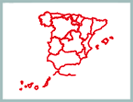Territorial policy (auntonomous communities)

Information on the Spanish system of the autonomous communities, its legal system and relations of the General Administration of the State with the autonomous communities.
With the statement of Article 2 of the Spanish Constitution as a starting point, which recognizes and guarantees the right to autonomy of the nationalities and regions of Spain, the title VIII of the Constitution establishes the territorial organisation of Spain, which consists of three levels: the State or central administration, the Autonomous Communities and the Local Entities.
Although in a strict sense, the establishement of the autonomous communities became effective based on a voluntary principle, since the Constituion did not configure the political map of the country, the result is that since 1983 the totality of the Spanish territory is divided into 17 Autonomous Communities, which was completed in 1995 with the adoption of the statutes of autonomy of the cities of Ceuta and Melilla.
The statute of autonomy is the basic institutional law of each autonomous community, which configures and develops both the institutional framework and the system of attribution of competencies, within the limits of articles 148 and 149 of the Constitution.
In brief, there are four types of areas and competences: those which exclusively corresponde to the State; those where the State legislates and the autonomous communities implement this legislation; a third type where the State adopts the basic legislation, while its legislative development and execution corresponds to the autonomous communities; and finally the exclusive competences of the autonomous communities.
The complexity of the system and the difficulty to specify it in the ordinary administrative activity has triggered frequent conflicts which have been resolved through the jurisprudence of the Constitutional Court. Through this conflict resolution system, this Court has played a very important role in the interpretation of the powers that correspond to the State and the autonomous communities.
The system has been made possible with the transfer of services and resources from the State to the autonomous communities, a gradual process of change of assignment of more than 820,000 civil servants who have become employees of the autonomous communities. With this starting point, the autonomous communities have been recruited their owm additional staff required to provide their services, including health care, education and social services.
But relations between the powers of the State and the autonomous communities are not only conceived in terms of potential conflict, but also in terms of cooperation. The intersections of competences, the shared nature of many of the competences and the need to articulate cooperative policies to be developed throughout the entire territory have driven to the creation of different instruments of cooperation that makes possible the functioning of a coherent and efficient autonomic system. This system has gradually been developed and consolidated taking into consideration the practice and experience. It may formally take two forms: multilateral or sectoral cooperation, bringing together the State and all the autonomous communities; and bilateral cooperation, bringing together the State and one autonomous community. In this system the Conference of Presidents and the sectoral conferences play a central role.
The system of autonomic cooperation has a special organization to respond to the challenges of the process of European integration. Consecutive reforms of the EU treaties have increased the powers of the European Union, having an impact on the internal distribution of competences. A new system of participation of the autonomous communities was articulated to respond to this challenge when the EU proposal impacts on the competences or interests of the autonomous communities. Similarly, the extension of external activities of the autonomous communities has forced to establish coordination instruments to ensure coherence and let this activity fit in the foreign attributions that exclusively correspond to the State.
Finally, the services provided by the Autonomous Communities require financial resources that are periodically reviewed and that have been effective through successive agreements on the funding model, been still in force today the one agreed in 2008. The consecutive systems include modifications and adaptations to the changing reality and they have been adopted as the autonomous communities get new responsibilities and provide new public services.
